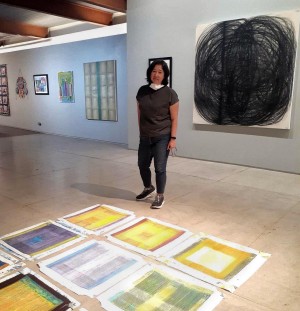Pep Manalang
grew up on a university campus in the Philippines but I have now lived in the US more than half my life. At age eight I moved to Pittsburgh, Pennsylvania with my mother who was pursuing her PhD at Pitt. After two years I returned to the University of the Philippines where I finished grade school, high school, and college. Upon graduating with a BS Physics degree I started teaching College Physics at the same university. After two years I moved to the US to pursue my PhD in Physics. It was in graduate school that I realized that I wanted to paint more than I wanted to be a scientist. I quickly finished up a Master’s degree at SUNY Buffalo, then applied to the Pennsylvania Academy of the Fine Arts (PAFA). Being in art school was a dream come true. Surrounded by talented artists, I was humbled, but motivated to improve myself and my work. I had started at PAFA thinking I would become a landscape painter but along the way my work turned abstract. It’s almost as if Abstraction chose me and not the other way around. After art school, I moved back to the Philippines, just after getting married, in order to empty out my mother’s house since she had passed away. My husband moved to the Philippines as well and we both worked as Physics instructors at the University. After a few years I stopped working at the University and started showing my work in the Metro Manila area. Ultimately we moved back to the US and we have led an almost nomadic existence, moving to whichever university my husband could get funding at. We’ve lived in New Hampshire, New York State, and Alaska. Now we are back in Dover, NH, by choice. In Alaska I pursued my MFA. Returning to school after a long break was difficult for me, having been an exhibiting artist for many years. I’ve often maintained that obtaining my MFA was much more difficult than getting a Master’s degree in Physics. It was, nevertheless, an enriching experience - surrounded by peers, and gaining teaching experience in art. It broadened my thinking and facilitated improvement in my work. My philosophy of art-making is influenced by the concept of mindfulness. I start with the bare minimum - a distilled idea and a preliminary composition. Working instinctively, the painting develops with a minimum of pre-planning. I am concerned with the process of creation being genuine and uncontrived. I do not want to be consciously aware of my decision- making process. I work with acrylic for immediacy because it enables me to make numerous changes rapidly. I often use particulate matter such as pumice, sand, and lumina. Materiality plays a central role in my work in the way it limits and facilitates ideas. I believe that an artwork has an array of possible directions so I take a leap of faith and keep an open mind. I aim to create paintings in an loose yet precise manner, without overthinking. There is a balancing act between opposing forces - the conscious versus the unconscious, control versus abandon.


